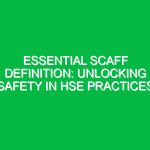Introduction
Hello team! Today, we’re here for a toolbox talk focused on an essential piece of equipment we often use on site: the Excavator Quick Coupler Device. This device plays a critical role in our daily operations, enhancing efficiency while also posing certain risks if not handled correctly. Understanding its proper use, potential Hazards, and Best Practices is vital for maintaining a safe working Environment. Let’s dive into the details!
What is an Excavator Quick Coupler Device?
The Excavator Quick Coupler Device is an attachment that allows operators to quickly and easily connect and disconnect various attachments to an excavator, such as buckets, grapples, or other tools. This device significantly reduces the time spent on changing attachments, which can increase productivity on the job site. However, with this convenience comes the responsibility of ensuring Safety and proper handling.
Importance of the Excavator Quick Coupler Device in HSE
In the context of Health, Safety, and Environment (HSE), the Excavator Quick Coupler Device plays a vital role in both operational efficiency and Safety. Here are a few important points to consider:
- Time Efficiency: Quick couplers allow for fast attachment changes, minimizing downtime and keeping the project on schedule.
- Safety: Proper use can prevent Manual Handling injuries associated with heavy attachments.
- Versatility: A single excavator can perform multiple tasks with various attachments, reducing the need for additional equipment.
Potential Hazards of Using the Excavator Quick Coupler Device
While the Excavator Quick Coupler Device offers many Benefits, it also presents certain hazards if not used properly. Here are some potential risks to be aware of:
- Improper Attachment: If the coupler is not securely fastened, attachments can detach during Operation, leading to accidents or equipment damage.
- Pinch Points: Operators and nearby workers can be at risk of pinch injuries when the coupler is being engaged or disengaged.
- Mechanical Failures: Wear and tear on the coupler can lead to failures if regular Maintenance checks are not conducted.
Best Practices for Using the Excavator Quick Coupler Device
To mitigate risks associated with the Excavator Quick Coupler Device, it’s crucial to follow these Best Practices:
1. Pre-Operational Checks
Before starting work, always conduct a thorough inspection of the quick coupler and the attachment. Look for signs of wear, damage, or loose components. Ensure that the locking mechanism is functioning properly.
2. Follow Manufacturer Instructions
Refer to the manufacturer’s manual for specific guidelines on using the Excavator Quick Coupler Device. Different models may have unique operating Procedures.
3. Use Spotters
When changing attachments, have a designated spotter to guide the operator. This helps ensure that the area is clear of personnel and obstacles, reducing the risk of accidents.
4. Secure Attachments Properly
Always double-check that the attachment is securely locked in place before operating the excavator. A quick visual inspection can help confirm that everything is in order.
5. Training and Competence
Only trained and authorized personnel should operate equipment with a quick coupler. Regular Training sessions will help keep skills sharp and reinforce Safety Measures.
Real-Life Example: A Cautionary Tale
Let’s take a moment to reflect on a hypothetical scenario: Imagine a busy construction site where a crew is using an excavator equipped with a quick coupler. One of the operators, eager to finish a task, hastily connects a new attachment without performing a proper inspection. Midway through the operation, the attachment detaches, causing it to swing wildly and narrowly miss a nearby worker. Thankfully, no one was injured, but this incident could have been avoided with proper checks and communication. This example emphasizes the importance of vigilance when using the Excavator Quick Coupler Device.
Compliance with Regulations and Standards
Compliance with relevant regulations and safety standards is crucial when operating the Excavator Quick Coupler Device. Familiarize yourself with the following:
- OSHA Standards: The Occupational Safety and Health Administration sets regulations regarding equipment safety that must be adhered to on all job sites.
- Manufacturer Guidelines: Each manufacturer provides specific guidelines on how to safely operate their equipment, including quick couplers.
- Company Policies: Always follow your company’s safety protocols related to equipment use and maintenance.
By complying with these standards, we not only ensure our safety but also protect our company from potential legal issues and financial liabilities.
Open Discussion: Your Experiences and Questions
Now, I’d like to open the floor for discussion. Have any of you had experiences—positive or negative—related to the Excavator Quick Coupler Device? What best practices do you follow, and do you have any questions or concerns about its use? Sharing our experiences can help us all learn and improve our safety practices on-site.
Conclusion
In conclusion, the Excavator Quick Coupler Device is a valuable tool that enhances our efficiency and versatility on the job site. However, it is essential to remain vigilant about safety practices. By conducting thorough inspections, following manufacturer guidelines, and engaging in open communication, we can minimize risks and maintain a safe working environment.
Thank you all for your attention and commitment to safety. Let’s keep these practices in mind as we move forward with our work today. Remember, safety is everyone’s responsibility!


